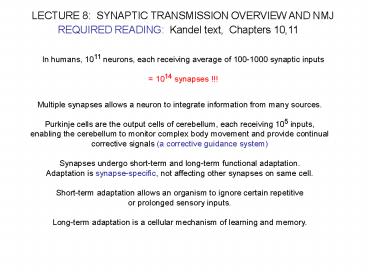LECTURE 8: SYNAPTIC TRANSMISSION OVERVIEW AND NMJ - PowerPoint PPT Presentation
1 / 16
Title:
LECTURE 8: SYNAPTIC TRANSMISSION OVERVIEW AND NMJ
Description:
Purkinje cells are the output cells of cerebellum, each receiving 105 inputs, enabling the cerebellum to monitor complex body movement and provide continual ... – PowerPoint PPT presentation
Number of Views:76
Avg rating:3.0/5.0
Title: LECTURE 8: SYNAPTIC TRANSMISSION OVERVIEW AND NMJ
1
LECTURE 8 SYNAPTIC TRANSMISSION OVERVIEW AND NMJ
REQUIRED READING Kandel text, Chapters 10,11
In humans, 1011 neurons, each receiving average
of 100-1000 synaptic inputs 1014 synapses !!!
Multiple synapses allows a neuron to integrate
information from many sources. Purkinje cells
are the output cells of cerebellum, each
receiving 105 inputs, enabling the cerebellum to
monitor complex body movement and provide
continual corrective signals (a corrective
guidance system) Synapses undergo short-term and
long-term functional adaptation. Adaptation is
synapse-specific, not affecting other synapses on
same cell. Short-term adaptation allows an
organism to ignore certain repetitive or
prolonged sensory inputs. Long-term adaptation
is a cellular mechanism of learning and memory.
2
ELECTRICAL VS. CHEMICAL SYNAPSES
FIGURE 10-1
TABLE 10-1
3
NEAR-INSTANTANEOUS TRANSMISSION ACROSS ELECTRICAL
SYNAPSES
Synaptic transmission is graded, occuring even in
the absence of action potential Transmission can
be BI-DIRECTIONAL
FIGURE 10-3
4
ELECTRICAL SYNAPSES ARE COMPOSED OF GAP-JUNCTION
CHANNELS
5
ELECTRICAL SYNAPSES ALLOW SYNCHRONOUS FIRING OF
CONNECTED CELLS
6
STEPS OF TRANSMISSION AT CHEMICAL SYNAPSES
Chemical synaptic transmission has a 0.3 - 5 msec
delay, depending upon type of post-synaptic
receptor Chemical synaptic transmission can
depolarize or inhibit depolarization, depending
upon type of post-synaptic receptor Sub-threshold
presynaptic depolarizations are not transmitted
7
DIRECT VS. INDIRECT GATING OF TRANSMISSION AT
CHEMICAL SYNAPSES
8
DIRECTLY GATED MONOSYNAPTIC TRANSMISSION AT THE
NEUROMUSCULAR JUNCTION
Large size of vertebrate neuromuscular junction
has facilitated electrophysiological and
morphological analysis of this synapse Each
muscle fiber receives input from a single motor
neuron axon Synaptic transmission employs a
single neurotransmitter, acetylcholine (Ach) and
a single species of directly-gated
neurotransmitter receptor (nicotinic AChR)
9
THE EXCITATORY POST-SYNAPTIC POTENTIAL
When recording Vm near endplate, stimulation of
motor axon generates complex depolarization in
muscle fiber, consisting of an excitatory postsyna
ptic potential (EPSP) and a following action
potential (AP). Partial inhibition of
AChRs With curare reduces EPSP Below firing
threshold For AP.
10
EPSP CURRENT APPEARS RAPIDLY AND DECAYS MORE
SLOWLY
11
EPSP CURRENT OBEYS OHMS LAW
IEPSP gEPSP x (VM - EEPSP)
12
SMOOTH EPSP CURRENT IS SUM OF CURRENTS FROM OPEN
ON/OFF CHANNELS
SINGLE-CHANNEL PATCH VOLTAGE CLAMP RECORDING OF
ACETYLCHOLINE-INDUCED CURRENT
REVERSAL POTENTIAL OF SINGLE CHANNEL SAME AS FOR
OVERALL EPSP
13
STEPS OF TRANSMISSION AT NEUROMUSCULAR JUNCTION
14
MODEL OF NICOTINIC ACETYLCHOLINE RECEPTOR
15
ACH-GATED CURRENT AND PASSIVE MEMBRANE
PROPERTIES DETERMINE DYNAMICS OF THE EPSP
16
NEXT LECTURE Synaptic Integration READING
KANDEL text, Chapter 12































